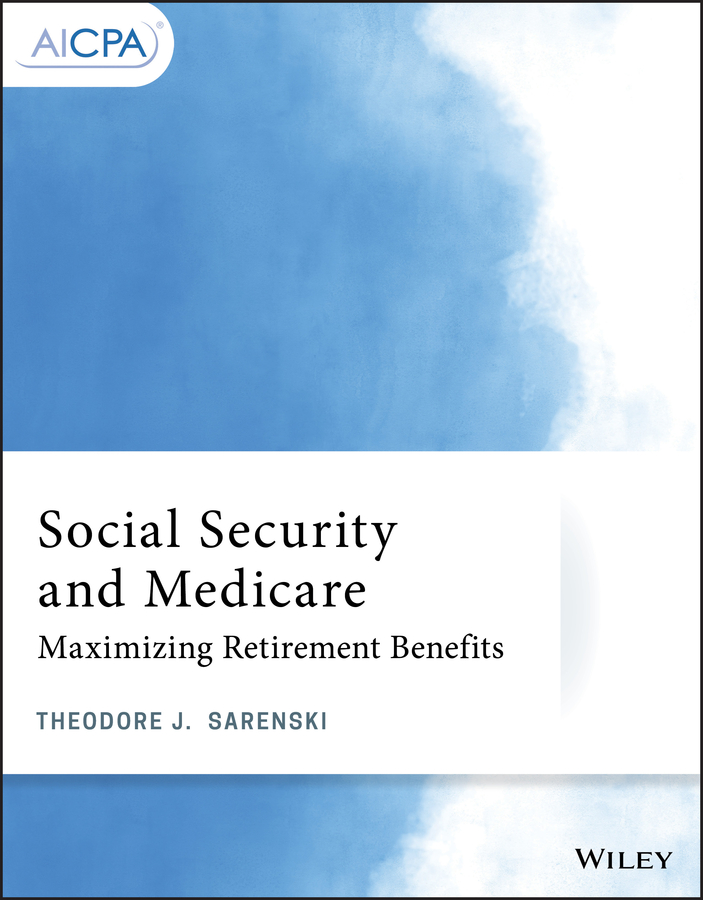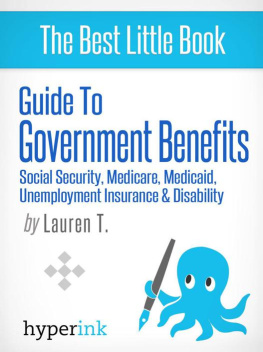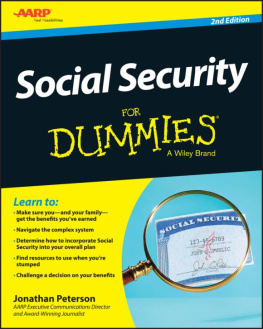
Table of Contents
Guide
Pages

SOCIAL SECURITY AND MEDICARE: MAXIMIZING RETIREMENT BENEFITS
BY THEODORE J. SARENSKI, CPA.PFS, CFP
Notice to readers
Social Security and Medicare: Maximizing Retirement Benefits is intended solely for use in continuing professional education and not as a reference. It does not represent an official position of the American Institute of Certified Public Accountants, and it is distributed with the understanding that the author and publisher are not rendering legal, accounting, or other professional services in the publication. This course is intended to be an overview of the topics discussed within, and the author has made every attempt to verify the completeness and accuracy of the information herein. However, neither the author nor publisher can guarantee the applicability of the information found herein. If legal advice or other expert assistance is required, the services of a competent professional should be sought.
You can qualify to earn free CPE through our pilot testing program.
If interested, please visit https://aicpacompliance.polldaddy.com/s/pilot-testing-survey.
2019 Association of International Certified Professional Accountants, Inc. All rights reserved.
For information about the procedure for requesting permission to make copies of any part of this work, please email with your request. Otherwise, requests should be written and mailed to Permissions Department, 220 Leigh Farm Road, Durham, NC 27707-8110 USA.
ISBN 978-1-119-73725-4 (paper)
ISBN 978-1-119-73734-6 (ePDF)
ISBN 978-1-119-73733-9 (ePub)
ISBN 978-1-119-73735-3 (obk)
Course Code: 745614
CL4SSM GS-0419-0A
Revised: April 2019
Chapter 1
How the Social Security System Operates
Learning objectives
- Recall that the Federal Insurance Contributions Act (FICA) tax applies to the funding of Social Security retirement, disability benefits, and Medicare benefits.
- Recognize how the additional Medicare tax operates.
- Identify instances in which there is no requirement for FICA taxation.
Overview
On August 14, 1935, the Social Security Act established a delivery system to provide old-age benefits for eligible workers, assistance for victims of industrial accidents, unemployment insurance benefits, and aid for dependent mothers and children, the blind, and the physically handicapped.
In 2016, the Social Security Administration (SSA) paid more than $1 trillion to more than 62 million recipients; 75% were retired workers and their dependents, 16% were disabled workers and their dependents, and 9% were survivors of deceased workers.
The Social Security Act authorized the Social Security Board, which now operates as the Social Security Administration, to register citizens for benefits, administer the contributions received by the federal government, and send payments to recipients. U.S. Social Security insurance is supported from contributions in the form of taxes on individuals wages and employers payrolls rather than directly from government funds. Tax revenue generated from the income tax on Social Security benefits received by the IRS from individuals personal income tax returns is also a source of funds to be paid to Social Security recipients.
A brief history of the Social Security Act
Before the 1930s, support for the elderly was generally the responsibility of the older individuals family rather than that of the federal government (except for veterans pensions). However, in light of the economic nightmare caused by the Great Depression, congressional support for numerous proposals for a national old-age insurance system arose. On January 17, 1935, President Franklin D. Roosevelt sent a message to Congress asking for economic security legislation.
The same day, Senator Robert Wagner of New York and Representative David Lewis of Maryland introduced bills reflecting the Roosevelt administrations wishes. The resulting Senate and House bills encountered opposition from those who considered it a governmental takeover of individual choice and from those who sought exemption from payroll taxes for employers who adopted government-approved pension plans. Eventually the bill passed both houses, and on August 14, 1935, President Roosevelt signed the Social Security Act into law. Originally, the Social Security Act of 1935 was named the Economic Security Act, but this title was changed during a Ways and Means Committee meeting on March 1, 1935. Congressman Frank Buck (D-Calif.) made a motion to change the name of the bill to the Social Security Act of 1935. The motion was carried by a voice vote of the committee.
Through the 80th anniversary of Social Security in the year 2015, the Social Security Act has had 12 major legislative changes. The changes have mostly added more workers subject to withholding of Social Security tax on wages, increased the age of eligibility, adjusted the amount of wages subject to Social Security withholding, and other changes meant to shore up what was a shortage of Social Security tax collections at various times in history.
The Bipartisan Budget Act of 2015 passed in November of 2015 rescinded two favorite methods of collecting Social Security benefits: the file and suspend and the restricted application for spousal benefits only at full retirement age (FRA). The two methods were first introduced in the Senior Citizens Freedom to Work Act of 2000.
File and suspend was a strategy that allowed a worker to file for Social Security benefits at full retirement age and then immediately suspend receiving those benefits to a later age up to age 70. The filing part allowed a spouse or qualifying child to start receiving Social Security benefits on that workers record even though the worker was delaying their own benefit. File and suspend is still allowed for those workers who were 66 by April 30, 2016. After that date, a spouse or qualifying child will only be allowed to collect a benefit on a workers record if that worker is actually collecting a benefit. Suspension of benefit collection is still available, meaning that a Social Security recipient between the ages of 62 and 70 can suspend collection of benefits and get additional credits from that moment to age 70. However, as of April 30, 2016, spousal and dependent benefits of that worker are also suspended.
Restricted application is a strategy that became popular after being introduced in the Senior Citizens Freedom to Work Act. It allowed a spouse at full retirement age to elect to collect only a spousal benefit on their spouses work record and defer the collecting of his or her own benefit to age 70, collecting an 8% per year credit to their own benefit. People born in 1953 and earlier will still be allowed to file a restricted application. Those people born after 1953 will get the higher of their own benefit or the spousal benefit when they file for Social Security benefit no matter what age they file for the benefit. Therefore, restricted application is still available for those turning age 66 for the next two years.
Lump sum was also eliminated in the Bipartisan Budget Act. The lump sum allowed a person to file and suspend at full retirement age and then at a later age, before age 70, change their mind and collect a lump sum benefit for all of the benefits they would have started receiving at full retirement age to their current age, and also get a monthly benefit starting immediately as if they had begun collecting benefits from full retirement age. The lump sum is only allowed for people who were age 66 by April 30, 2016.
Next page







